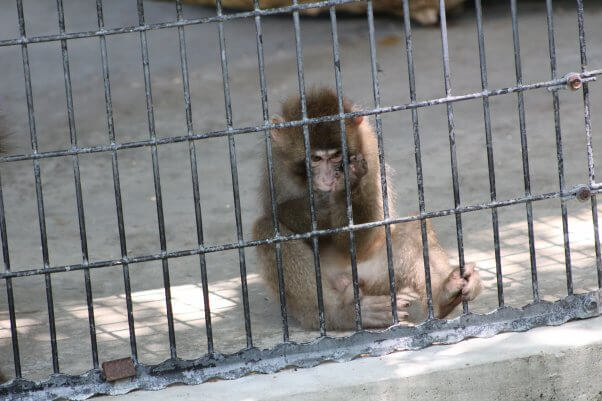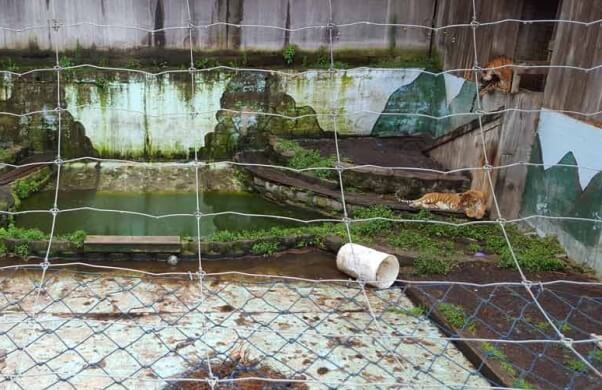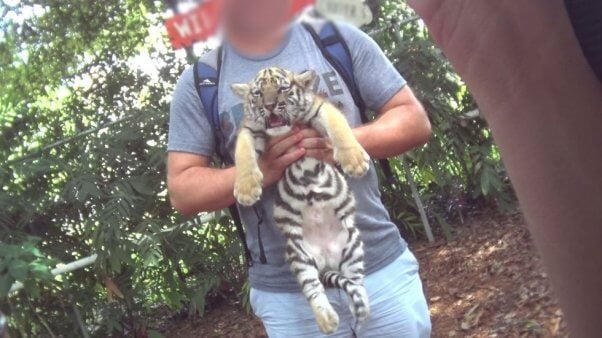The recent deaths of a woman and the lion who killed her in North Carolina have some asking, “What’s up with lions in North Carolina?” and “What’s a roadside zoo?” Ranging from a handful of animals in backyard pens to dozens jammed into ramshackle cages, hundreds of these sleazy menageries can be found all over the country.
Just about anybody —whether or not they have any qualifications —can apply for and receive a U.S. Department of Agriculture animal exhibitor’s license. Roadside zoos are typically privately owned and on precarious financial footing. At these facilities, naturally free-ranging animals like lions, bears, tigers and primates are usually housed in cramped cages consisting of chain-link fencing and concrete floors. Their comfort is an afterthought.
Since most of these places operate with little staff or money, cages are often poorly maintained and filled with urine and feces. The grounds are typically littered with garbage and abandoned “construction projects.” The animals may not be provided with any kind of enrichment to help them pass the interminable days, beyond an old tire or a dead tree branch. Veterinary care, even for animals who are sick and injured, may be of the “do it yourself” variety.
At one California wildlife “sanctuary,” a running water hose was shoved into a dying tiger’s mouth. No vet was called, and after the animal died, people were encouraged to take photos with her corpse. At an Oklahoma facility, the owner, not a veterinarian, attempted to stitch up a bear’s 4- to 8-inch wound. Not surprisingly, the bear died.
Oversight of visitors to roadside zoos may be minimal. As a result, animals have been harassed, bludgeoned and stolen by people who were able to gain access to the exhibits. Others have died after ingesting coins, garbage and other items thrown into the cages.
Because animals in roadside zoos have such a poor quality of life, many develop an abnormal, repetitive form of behavior known as “zoochosis.” Bears pace back and forth like crazed automatons, birds pluck out their own feathers until they’re bald, and stressed primates bite their own limbs, leaving them bloodied and raw.
Many roadside zoos deliberately breed animals because they know that babies are profitable photo props and bring customers through the entrance gates. Tiger and bear cubs are exploited almost from the day they’re born. The owner of an Indiana facility that churns out cubs for public “playtime” was caught on video telling visitors to smack tiger cubs on the nose if they got too “rowdy” and dangled a 14-week-old bear cub by the mouth. At a Florida tiger cub breeding mill, exhausted, struggling and screaming cubs just weeks old were forced to swim with paying customers.
The seedy animal exhibition industry often seems to appeal to the most unsavory characters. One longtime roadside zoo operator was recently arrested on a slew of federal charges related to violations of wildlife-protection laws and two counts of murder-for-hire. An employee of another facility was arrested on charges of molesting children. The owners of a South Dakota bear breeding mill pleaded guilty to selling bears’ body parts illegally. And a convicted drug kingpin currently operates a Florida roadside zoo.
If your family is planning a vacation, there’s an easy way to save time and gas and avoid returning home with awful memories: Simply bypass decrepit roadside zoos and other cruel tourist traps that display animals. Vacationers with money to spend keep these archaic exhibits in business, and animals will continue to suffer and die in them as long as people heed the call of interstate billboards and pull over to buy a ticket.









